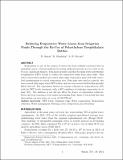Reducing Evaporative Water Losses from Irrigation Ponds through the Reuse of Polyethylene Terephthalate Bottles
Author(s)
Shanbhag, R.; Simon, Kevin P.; Slocum, Alexander H.
DownloadJIDEWaterEvap_V6.pdf (1.651Mb)
OPEN_ACCESS_POLICY
Open Access Policy
Creative Commons Attribution-Noncommercial-Share Alike
Terms of use
Metadata
Show full item recordAbstract
Evaporation is one of the sources of water loss from artificial reservoirs used by the agricultural sector. Current methods of covering artificial reservoirs are too costly to be used by poor, small-scale farmers. This paper presents a method for using waste polyethylene terephthalate (PET) bottles to reduce the evaporative losses from open tanks. This water-conservation method was tested using eight evaporation pans with daily water level measurements to record evaporation rate. Four pans were used as controls, two were covered with empty waste PET bottles, and two were covered with bottles partially filled with soil. The experiment showed an average reduction in evaporation by 40% with the PET bottle treatment, with a 90% confidence of reducing evaporation by at least 18%. The addition of soil did not affect the degree of evaporation reduction. Given the local economics of the region surrounding Pune, India, it was found that this intervention can save water at a cost of US$0.09/m[superscript 3].
Date issued
2015-10Department
Massachusetts Institute of Technology. Department of Mechanical Engineering; Massachusetts Institute of Technology. Engineering Systems DivisionJournal
Journal of Irrigation and Drainage Engineering
Publisher
American Society of Civil Engineers (ASCE)
Citation
Simon, K., R. Shanbhag, and A. H. Slocum. “Reducing Evaporative Water Losses from Irrigation Ponds through the Reuse of Polyethylene Terephthalate Bottles.” J. Irrig. Drain Eng. (October 9, 2015): 06015005.
Version: Author's final manuscript
ISSN
0733-9437
1943-4774